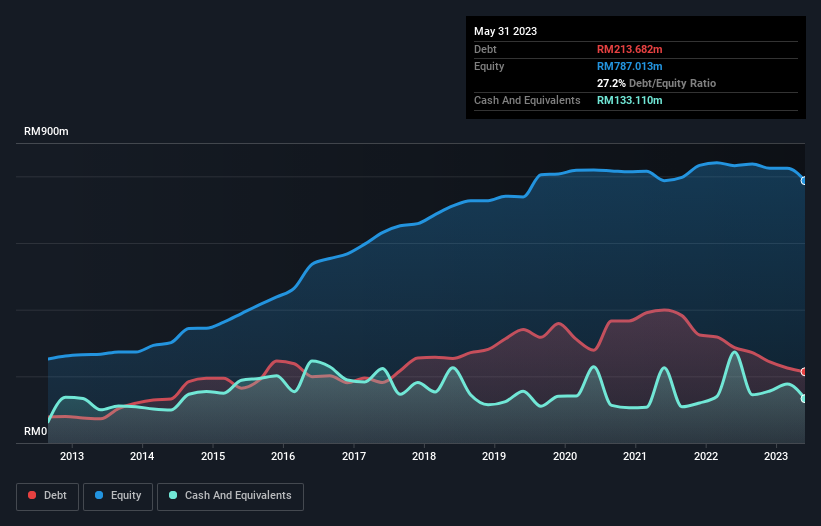David Iben put it well when he said, 'Volatility is not a risk we care about. What we care about is avoiding the permanent loss of capital.' It's only natural to consider a company's balance sheet when you examine how risky it is, since debt is often involved when a business collapses. We note that Gadang Holdings Berhad (KLSE:GADANG) does have debt on its balance sheet. But the real question is whether this debt is making the company risky.
When Is Debt Dangerous?
Debt is a tool to help businesses grow, but if a business is incapable of paying off its lenders, then it exists at their mercy. Ultimately, if the company can't fulfill its legal obligations to repay debt, shareholders could walk away with nothing. However, a more frequent (but still costly) occurrence is where a company must issue shares at bargain-basement prices, permanently diluting shareholders, just to shore up its balance sheet. By replacing dilution, though, debt can be an extremely good tool for businesses that need capital to invest in growth at high rates of return. When we examine debt levels, we first consider both cash and debt levels, together.
View our latest analysis for Gadang Holdings Berhad
What Is Gadang Holdings Berhad's Debt?
As you can see below, Gadang Holdings Berhad had RM213.7m of debt at May 2023, down from RM286.1m a year prior. On the flip side, it has RM133.1m in cash leading to net debt of about RM80.6m.

A Look At Gadang Holdings Berhad's Liabilities
Zooming in on the latest balance sheet data, we can see that Gadang Holdings Berhad had liabilities of RM301.0m due within 12 months and liabilities of RM301.5m due beyond that. On the other hand, it had cash of RM133.1m and RM284.0m worth of receivables due within a year. So its liabilities total RM185.3m more than the combination of its cash and short-term receivables.
This is a mountain of leverage relative to its market capitalization of RM233.0m. Should its lenders demand that it shore up the balance sheet, shareholders would likely face severe dilution. When analysing debt levels, the balance sheet is the obvious place to start. But ultimately the future profitability of the business will decide if Gadang Holdings Berhad can strengthen its balance sheet over time. So if you're focused on the future you can check out this free report showing analyst profit forecasts.
Over 12 months, Gadang Holdings Berhad made a loss at the EBIT level, and saw its revenue drop to RM496m, which is a fall of 24%. That makes us nervous, to say the least.
Caveat Emptor
Not only did Gadang Holdings Berhad's revenue slip over the last twelve months, but it also produced negative earnings before interest and tax (EBIT). Indeed, it lost RM22m at the EBIT level. Considering that alongside the liabilities mentioned above does not give us much confidence that company should be using so much debt. Quite frankly we think the balance sheet is far from match-fit, although it could be improved with time. For example, we would not want to see a repeat of last year's loss of RM29m. So we do think this stock is quite risky. There's no doubt that we learn most about debt from the balance sheet. But ultimately, every company can contain risks that exist outside of the balance sheet. Case in point: We've spotted 2 warning signs for Gadang Holdings Berhad you should be aware of.
At the end of the day, it's often better to focus on companies that are free from net debt. You can access our special list of such companies (all with a track record of profit growth). It's free.
New: Manage All Your Stock Portfolios in One Place
We've created the ultimate portfolio companion for stock investors, and it's free.
• Connect an unlimited number of Portfolios and see your total in one currency
• Be alerted to new Warning Signs or Risks via email or mobile
• Track the Fair Value of your stocks
Have feedback on this article? Concerned about the content? Get in touch with us directly. Alternatively, email editorial-team (at) simplywallst.com.
This article by Simply Wall St is general in nature. We provide commentary based on historical data and analyst forecasts only using an unbiased methodology and our articles are not intended to be financial advice. It does not constitute a recommendation to buy or sell any stock, and does not take account of your objectives, or your financial situation. We aim to bring you long-term focused analysis driven by fundamental data. Note that our analysis may not factor in the latest price-sensitive company announcements or qualitative material. Simply Wall St has no position in any stocks mentioned.
About KLSE:GADANG
Gadang Holdings Berhad
An investment holding company, engages in civil engineering and construction, property development, water supply, and mechanical and electrical engineering businesses in Malaysia, Indonesia, and Singapore.
Flawless balance sheet with proven track record.
Market Insights
Community Narratives



